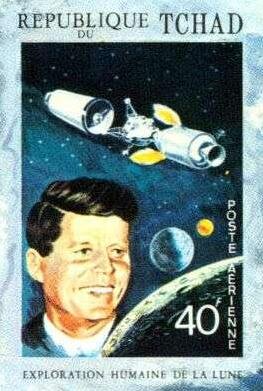Stamp: John F. Kennedy & Apollo Space Craft (Chad 1971)
John F. Kennedy & Apollo Space Craft (Chad 1971)
16 February (Chad ) within release Space Exploration goes into circulation Stamp John F. Kennedy & Apollo Space Craft face value 40 Central African CFA franc
| Stamp John F. Kennedy & Apollo Space Craft in catalogues | |
|---|---|
| Michel: | Mi: TD 351B |
Stamp is square format.
Stamp from mini sheetAlso in the issue Space Exploration:
- Stamp - Apollo Program face value 8;
- Stamp - Apollo 11 face value 10;
- Stamp - Soviet Space face value 35;
- Souvenir Sheet - John F. Kennedy & Apollo Space Craft face value 40;
- Souvenir Sheet - John F. Kennedy & Apollo Space Craft face value 40;
- Stamp - John F. Kennedy & Apollo Space Craft face value 40;
- Stamp - John F. Kennedy & Apollo Space Craft face value 40;
Stamp John F. Kennedy & Apollo Space Craft it reflects the thematic directions:
A globe is a spherical model of Earth, of some other celestial body, or of the celestial sphere. Globes serve purposes similar to maps, but, unlike maps, they do not distort the surface that they portray except to scale it down. A model globe of Earth is called a terrestrial globe. A model globe of the celestial sphere is called a celestial globe
A head of state (or chief of state) is the public persona that officially represents the national unity and legitimacy of a sovereign state. In some countries, the head of state is a ceremonial figurehead with limited or no executive power, while in others, the head of state is also the head of government. In countries with parliamentary governments, the head of state is typically a ceremonial figurehead that does not actually guide day-to-day government activities and may not be empowered to exercise any kind of secular political authority (e.g., Queen Elizabeth II as Head of the Commonwealth). In countries where the head of state is also the head of government, the president serves as both a public figurehead and the actual highest ranking political leader who oversees the executive branch (e.g., the President of the United States).
The Moon is Earth's only natural satellite. It orbits at an average distance of 384,400 km (238,900 mi), about 30 times the diameter of Earth. Tidal forces between Earth and the Moon have over time synchronized the Moon's orbital period (lunar month) with its rotation period (lunar day) at 29.5 Earth days, causing the same side of the Moon to always face Earth. The Moon's gravitational pull – and to a lesser extent, the Sun's – are the main drivers of Earth's tides.
Outer space (or simply space) is the expanse that exists beyond Earth's atmosphere and between celestial bodies. It contains ultra-low levels of particle densities, constituting a near-perfect vacuum of predominantly hydrogen and helium plasma, permeated by electromagnetic radiation, cosmic rays, neutrinos, magnetic fields and dust. The baseline temperature of outer space, as set by the background radiation from the Big Bang, is 2.7 kelvins (−270 °C; −455 °F)
A spacecraft is a vehicle that is designed to fly and operate in outer space. Spacecraft are used for a variety of purposes, including communications, Earth observation, meteorology, navigation, space colonization, planetary exploration, and transportation of humans and cargo. All spacecraft except single-stage-to-orbit vehicles cannot get into space on their own, and require a launch vehicle (carrier rocket).






